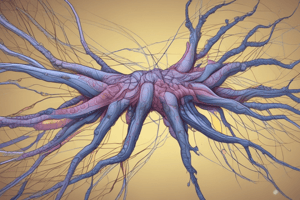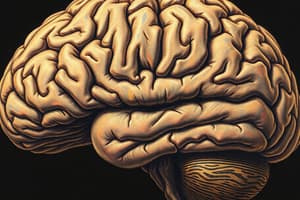Podcast
Questions and Answers
What is a neuron?
What is a neuron?
- A type of bone cell
- A nerve cell; the basic building block of the nervous system (correct)
- A brain cell
- A type of muscle cell
What are astrocytes?
What are astrocytes?
- Neurons that transmit signals
- Star-shaped glial cells in the brain and spinal cord (correct)
- Types of neurotransmitters
- Muscle cells
What is the function of an axon hillock?
What is the function of an axon hillock?
It is the part connecting soma and axon, where membrane potentials are summated before being transmitted to the axon.
What differentiates general senses from special senses?
What differentiates general senses from special senses?
What is grey matter?
What is grey matter?
What is white matter?
What is white matter?
Define monosynaptic reflex.
Define monosynaptic reflex.
What is a polysynaptic reflex?
What is a polysynaptic reflex?
What is the role of a somatic motor neuron?
What is the role of a somatic motor neuron?
What are the primary functions of sympathetic neurons?
What are the primary functions of sympathetic neurons?
What are visceral sensory neurons part of?
What are visceral sensory neurons part of?
Describe a bipolar neuron.
Describe a bipolar neuron.
What characterizes a multipolar neuron?
What characterizes a multipolar neuron?
What is the function of glial cells?
What is the function of glial cells?
What is the brain's primary role?
What is the brain's primary role?
What does CNS stand for?
What does CNS stand for?
What does PNS stand for?
What does PNS stand for?
What are autonomic nerves responsible for?
What are autonomic nerves responsible for?
What is a nerve impulse?
What is a nerve impulse?
Define an axon.
Define an axon.
What is a dendrite?
What is a dendrite?
What are Schwann cells?
What are Schwann cells?
What is the node of Ranvier?
What is the node of Ranvier?
What occurs at a synapse?
What occurs at a synapse?
What is the role of receptors?
What is the role of receptors?
Define effectors in the nervous system.
Define effectors in the nervous system.
What is a stimulus?
What is a stimulus?
What is the cell body of a neuron?
What is the cell body of a neuron?
What is myelin?
What is myelin?
Define reflex.
Define reflex.
What is resting potential?
What is resting potential?
What is action potential?
What is action potential?
Define refractory period.
Define refractory period.
What is a neurotransmitter?
What is a neurotransmitter?
What is the spinal cord?
What is the spinal cord?
What is the cerebellum responsible for?
What is the cerebellum responsible for?
What is the cerebrum?
What is the cerebrum?
What is the corpus callosum?
What is the corpus callosum?
What is the role of the pons?
What is the role of the pons?
What does the medulla oblongata regulate?
What does the medulla oblongata regulate?
What are endorphins?
What are endorphins?
What is the retina?
What is the retina?
What are rods?
What are rods?
What are cones?
What are cones?
What is the pinna?
What is the pinna?
What is the eardrum?
What is the eardrum?
What is the cochlea?
What is the cochlea?
What are olfactory cells?
What are olfactory cells?
What is the autonomic nervous system?
What is the autonomic nervous system?
What are eustachian tubes?
What are eustachian tubes?
Define Parkinson's Disease.
Define Parkinson's Disease.
What is Alzheimer's Disease?
What is Alzheimer's Disease?
Define ALS.
Define ALS.
What is Multiple Sclerosis?
What is Multiple Sclerosis?
Flashcards are hidden until you start studying
Study Notes
Neuron and Glial Cells
- Neurons are the essential nerve cells that form the basis of the nervous system.
- Astrocytes are star-shaped glial cells located in the brain and spinal cord, playing a key supportive role.
Neuron Structure
- The axon hillock is the junction where the cell body (soma) meets the axon; it is crucial for summing membrane potentials.
- Dendrites are extensions that receive signals and direct impulses toward the cell body.
- The axon conducts impulses away from the neuron’s cell body, while action potentials are changes in electrical potential during stimulation.
Nervous System Components
- Grey matter consists of unmyelinated sheaths, cell bodies, synapses, and capillaries, primarily found in the CNS.
- White matter contains myelinated axons that facilitate communication between different grey matter regions.
Reflexes
- Monosynaptic reflexes involve a direct connection between sensory and motor neurons, exemplified by the knee-jerk reflex.
- Polysynaptic reflexes engage one or more interneurons for processing sensory input, as seen with pain responses (e.g., touching a hot surface).
Types of Neurons
- Somatic motor neurons control voluntary movements, linking sensory input with motor responses.
- Bipolar neurons have two extensions and are involved in transmitting special sensory information; they are specialized for smell, sight, taste, hearing, and vestibular functions.
- Multipolar neurons, the most abundant in the CNS, have one axon and multiple dendrites.
Autonomic Nervous System
- The autonomic nervous system (ANS) manages involuntary activities, with visceral sensory neurons sending signals from internal organs.
- Sympathetic neurons support the "Fight or Flight" response with short first and long second axons, while parasympathetic neurons facilitate "Rest and Digest" functions through long first and short second axons.
Brain and Spinal Components
- The brain coordinates nervous system activities and includes structures such as the cerebrum (thinking) and cerebellum (balance).
- The spinal cord links the brain with the rest of the body, playing a vital role in reflex arcs.
Action Potentials and Synaptic Transmission
- Resting potential refers to the electrical difference across a neuron's membrane when inactive.
- Neurotransmitters are chemical messengers that cross synapses, influencing whether an action potential will occur.
Sensory organs and receptors
- The retina contains rods and cones, crucial for vision; rods detect dim light, while cones enable color vision.
- The pinna collects sound waves and channels them into the auditory canal, leading to the eardrum, which vibrates in response to sound.
Neurological Disorders
- Parkinson's Disease results in tremors and movement difficulties due to neurodegeneration.
- Alzheimer's Disease leads to progressive memory loss and cognitive decline.
- ALS, or Lou Gehrig's Disease, progressively impacts motor neurons without affecting cognitive function.
- Multiple Sclerosis involves the destruction of myelin, disrupting motor activity.
Supporting Structures
- Schwann cells form myelin around axons, while nodes of Ranvier are gaps in the myelin sheath that enhance impulse speed.
- Eustachian tubes connect the ear to the throat, helping to equalize pressure within the ear.
Studying That Suits You
Use AI to generate personalized quizzes and flashcards to suit your learning preferences.




